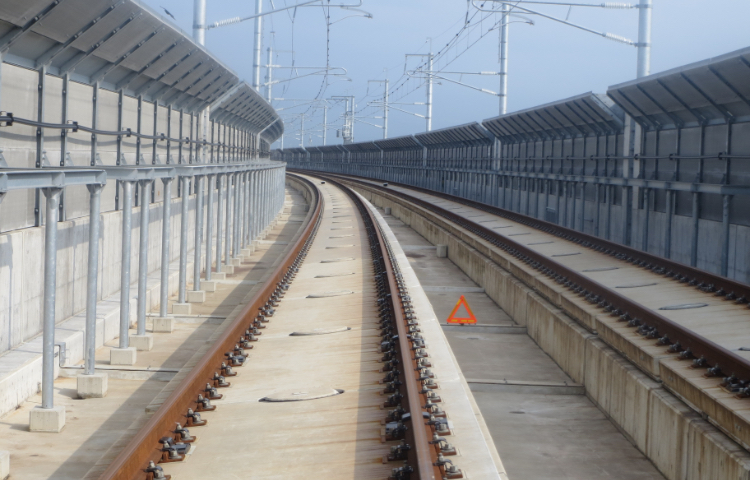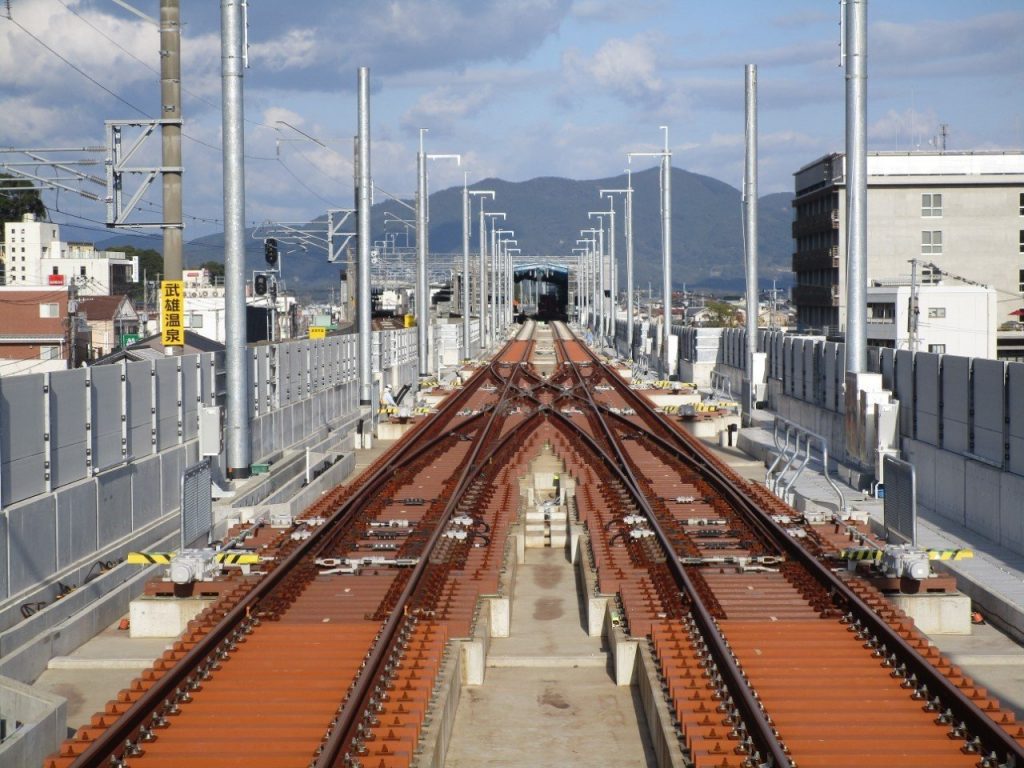Infrastructure • High speed Rail • Japan
➤ See also: Shinkansen overview – JR Hokkaïdo – JR East – JR Central – JR West – JR Kyushu
➤ See also: High speed train in France – High speed train in Germany – High speed train in Italy – Economics
Note: For educational purpose only. This page is meant purely as a documentation tool and has no legal effect. It is not a substitute for the official page of the operating company, manufacturer or official institutions. It cannot be used for staff training, which is the responsibility of approved institutions and companies.
👉 (Version française disponible)
In brief
➤ See first chapter – Shinkansen overview
The Shinkansen, Japan’s high-speed rail network, exemplifies advanced rail infrastructure designed for safety, efficiency, and resilience in a seismically active country. The tracks predominantly utilize slab track systems instead of traditional ballast, which enhances stability and reduces maintenance requirements. Slab track is composed of pre-stressed concrete slabs set on a bed of concrete, providing a rigid and durable foundation that withstands vibrations and high speeds. This structure not only improves stability but also reduces noise and track deformation, critical at speeds over 300 km/h.
Infrastructure managers: 5 private companies
Main HS operators: 5 private operators
First services: October 1964
Lenght of network : 2,730km (with reference to lines with ≥ 250 km/h speed, 25kV supply)
To handle Japan’s frequent earthquakes, Shinkansen infrastructure incorporates sophisticated seismic resilience technologies. One key system is the Urgent Earthquake Detection and Alarm System (UrEDAS), which uses a network of sensors to detect seismic activity and automatically halt trains if necessary. Shinkansen lines also use seismically isolated bridges and flexible joints in tunnels, which allow infrastructure to absorb and adapt to shocks, minimizing the risk of catastrophic failure during earthquakes.
Shinkansen routes include numerous tunnels and bridges, each designed to support the network’s resilience and efficiency. Tunnel construction uses advanced engineering techniques, including dual-layered linings that absorb vibrations and prevent water infiltration, essential for tunnel longevity and passenger safety. Bridges are designed with flexibility and redundancy, often using steel-reinforced concrete that can withstand both high-speed train vibrations and seismic shifts.
Signaling systems on Shinkansen lines are fully automated and digitally controlled. The network primarily relies on Automatic Train Control (ATC) to maintain safe distances and manage speeds, using a centralized traffic management system for real-time monitoring. This system allows precise control of train operations, minimizing risks of collisions or derailments. Overall, the Shinkansen’s infrastructure showcases the integration of advanced materials, automated safety protocols, and seismic engineering, ensuring safe and efficient travel even in Japan’s challenging geographical conditions.
The definition of a high-speed train varies by region, but generally, it refers to trains that operate at speeds of at least 250 km/h (155 mph) on newly built lines and 200 km/h (124 mph) on upgraded lines. In Europe, for example, the UIC (International Union of Railways) considers a commercial speed of 250 km/h as the principal criterion for high-speed rail. In the United States, the definition can include trains operating at speeds ranging from 180 km/h (110 mph) to 240 km/h (150 mph).
➤ See the UIC definition
Ballastless track
The J-Slab system is an advanced construction technology widely used in Japan, known for its efficiency in creating robust, earthquake-resistant infrastructure. This method uses prefabricated concrete slabs, known as J-Slabs, which are produced off-site in specialized factories and then transported to the construction site for installation. By manufacturing these slabs under controlled conditions, the J-Slab system ensures higher precision and quality than traditional, on-site concrete pouring methods. As a result, construction using J-Slabs is faster, more cost-effective, and produces buildings and structures with consistent structural integrity.
The full-fledged use of slab track began in 1982 when the Tohoku Shinkansen (Tokyo to Morioka) and Joetsu Shinkansen (Tokyo to Niigata) lines were constructed. These lines were built with significant portions using slab track from the outset.
Technologically, the first developments of J-Slab involves:
- A 100 mm, protective concrete layer, then a concrete support layer that sets the cant wherever it is required, on viaduct, or a base compacted granular material layer on embankment.
- Circular abutments that ensure longitudinal as well as lateral track blocking.
- A 4.95 m long slab, which is finally set on an asphalt-cement mortar to ensure elasticity and profile adjustment.

One of the primary advantages of the J-Slab system is its resilience to earthquakes, a critical consideration in Japan’s construction industry due to the country’s high seismic activity. The system incorporates pre-stressed concrete technology, which makes the slabs both strong and flexible, enabling them to absorb and dissipate seismic forces more effectively than conventional methods.
This ability to withstand seismic events makes the J-Slab system a preferred choice for residential, commercial, and even high-rise buildings in Japan. Moreover, the modularity of J-Slabs allows for versatile designs that can be tailored to various architectural needs without compromising safety.
One of the primary advantages of the J-Slab system is its resilience to earthquakes, a critical consideration in Japan’s construction industry due to the country’s high seismic activity. The system incorporates pre-stressed concrete technology, which makes the slabs both strong and flexible, enabling them to absorb and dissipate seismic forces more effectively than conventional methods. This ability to withstand seismic events makes the J-Slab system a preferred choice for residential, commercial, and even high-rise buildings in Japan. Moreover, the modularity of J-Slabs allows for versatile designs that can be tailored to various architectural needs without compromising safety.
The J-Slab system also contributes to a more sustainable construction process. Since the slabs are fabricated in factories, there is minimal waste generated on construction sites, and fewer materials need to be transported. Additionally, prefabrication reduces the environmental impact by optimizing the use of resources and energy in a controlled factory setting. Faster construction times also translate to less disruption in urban areas, which is particularly advantageous in Japan’s densely populated cities. The system’s emphasis on quality and durability further reduces the need for repairs and rebuilding, enhancing the longevity of the structures and lowering the environmental costs over the life of the building.
This approach to construction has also contributed to workforce safety and efficiency. With a significant portion of the work completed off-site in a controlled environment, there is less exposure to on-site hazards, reducing accidents and injuries among construction workers. Furthermore, Japan’s aging workforce in the construction industry has increased the demand for methods like the J-Slab system, which requires fewer manual laborers on-site and can be executed with a relatively small team, making it an efficient solution amidst labor shortages.


With new Shinkansen lines like the Nagano Shinkansen (now part of the Hokuriku Shinkansen) and various extensions to the Tohoku and Kyushu Shinkansen, slab track became since 1997 the standard track system. This choice was driven by its lower maintenance costs, longer lifespan, and better stability for high-speed operations.
The J-slab system was installed in Japan on more than 1000 km of Shinkansen lines, but also in Korea on the (Taegu-Pusan) south section of the Seoul-Pusan line, and finally in Taiwan (2007) where a technology derived from JSlab and German is implemented. 🟧
Shinkansen rolling stock →
👉 (Version française disponible)
[TOP]
Infrastructure • High speed Rail • Lexical
